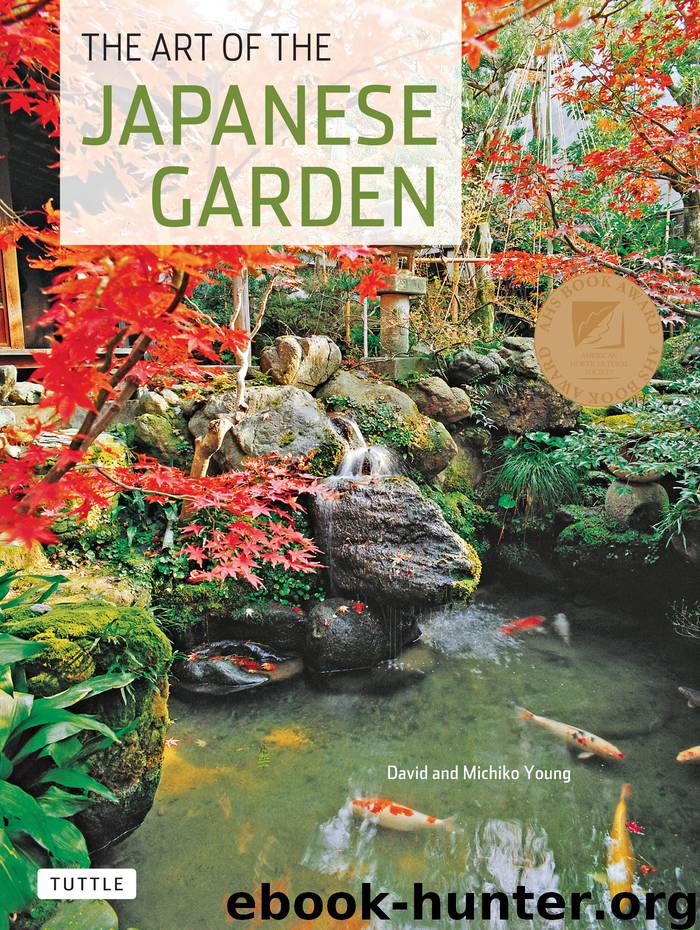The Art of the Japanese Garden by David Young & Michiko Young

Author:David Young & Michiko Young
Language: eng
Format: epub
ISBN: 978-1-4629-0582-9
Publisher: Tuttle Publishing
Detail of the rock arrangement in the photograph above.
Kinkakuji Temple
Kinkakuji Temple (Temple of the Golden Pavilion) in Kyoto was constructed by the third Ashikaga shogun for use as a private residence. It was later converted to a Zen temple. The elegant three-storied structure is situated in a stroll garden organized around a pond containing ten islands. Other features of the garden include an earlier pond, a Dragon Gate waterfall and a teahouse.
History
In 1397 (Muromachi Period), the third Ashikaga shogun, Yoshimitsu, began construction of a villa on the grounds of an old mansion belonging to the Saionji court family in the northern part of Kyoto City. The villa, Kitayamaden, was constructed as a retreat where the former shogun, who had abdicated in favor of his son, could concentrate on religion and the arts. In addition to the Golden Pavilion, the villa included two Shinden style palaces, one used as a private residence and the other used for entertaining guests. In 1407, thirteen new buildings were constructed in preparation for a visit the following year by reigning Emperor Gokomatsu. It was very unusual for an emperor to visit a shogun, so Yoshimitsu went to great lengths to entertain his royal guest, organizing elaborate parties lasting for twenty-one days.
The Golden Pavilion combines Chinese Song architectural influences and indigenous forms. The resulting edifice, while eclectic, is well integrated and graceful. It was positioned to afford a good view of the pond as well as the mountains to the west and north of Kyoto, an example of employing borrowed scenery to improve and extend the view. The first floor, constructed of unpainted wood and white plaster, was used for receiving guests and for embarking on rides in ornate Chinese style boats, reminiscent of Heian Period boating parties. The second and third floors are covered with gold leaf, from whence the popular name, Golden Pavilion, is derived. The pavilion was used for religious purposes as well as for discussions and tea drinking with close friends and political advisers.
After Yoshimitsu's death, the villa was turned into a Zen temple known as Rokuonji. Over the years, most of the buildings were lost to war and decay until today only the Golden Pavilion and the pond garden remain from early days. Partial restoration was carried out in the Edo Period, and again in the Meiji Period. The Golden Pavilion was burned by a crazed priest in 1950 and reconstructed in 1955. In 1987, a layer of gold leaf, five times the original thickness, was applied to the second and third floors. Kinkakuji was designated a UNESCO World Cultural Heritage Site in 1994.
Download
This site does not store any files on its server. We only index and link to content provided by other sites. Please contact the content providers to delete copyright contents if any and email us, we'll remove relevant links or contents immediately.
Turbulence by E. J. Noyes(7039)
The Thirst by Nesbo Jo(5786)
Gerald's Game by Stephen King(3918)
Be in a Treehouse by Pete Nelson(3213)
Marijuana Grower's Handbook by Ed Rosenthal(3119)
The Sprouting Book by Ann Wigmore(3053)
The Red Files by Lee Winter(2914)
The Remains of the Day by Kazuo Ishiguro(2619)
Sharp Objects: A Novel by Gillian Flynn(2445)
Christian (The Protectors Book 1) by L. Ann Marie(2395)
Organic Mushroom Farming and Mycoremediation by Tradd Cotter(2307)
The Culinary Herbal by Susan Belsinger(2062)
Stone Building by Kevin Gardner(1995)
The Starter Garden Handbook by Alice Mary Alvrez(1925)
Lilac Girls by Martha Hall Kelly(1876)
The Unlikely Pilgrimage of Harold Fry by Rachel Joyce(1836)
The Lean Farm Guide to Growing Vegetables: More In-Depth Lean Techniques for Efficient Organic Production by Ben Hartman(1785)
Urban Farming by Thomas Fox(1749)
Backyard Woodland by Josh VanBrakle(1587)
